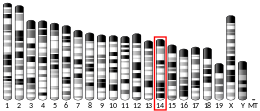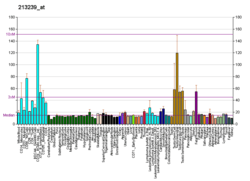PIBF1
Progesterone-induced-blocking factor 1 is a protein that in humans is encoded by the PIBF1 gene.[5][6] It has been shown to localize to the centrosome[7] and has also been named CEP90.[8]
References
- GRCh38: Ensembl release 89: ENSG00000083535 - Ensembl, May 2017
- GRCm38: Ensembl release 89: ENSMUSG00000022064 - Ensembl, May 2017
- "Human PubMed Reference:". National Center for Biotechnology Information, U.S. National Library of Medicine.
- "Mouse PubMed Reference:". National Center for Biotechnology Information, U.S. National Library of Medicine.
- Rozenblum E, Vahteristo P, Sandberg T, Bergthorsson JT, Syrjakoski K, Weaver D, Haraldsson K, Johannsdottir HK, Vehmanen P, Nigam S, Golberger N, Robbins C, Pak E, Dutra A, Gillander E, Stephan DA, Bailey-Wilson J, Juo SH, Kainu T, Arason A, Barkardottir RB, Nevanlinna H, Borg A, Kallioniemi OP (Apr 2002). "A genomic map of a 6-Mb region at 13q21-q22 implicated in cancer development: identification and characterization of candidate genes". Hum Genet. 110 (2): 111–21. doi:10.1007/s00439-001-0646-6. PMID 11935316.
- "Entrez Gene: C13orf24 chromosome 13 open reading frame 24".
- Lachmann M, Gelbmann D, Kálmán E, et al. (2004). "PIBF (progesterone induced blocking factor) is overexpressed in highly proliferating cells and associated with the centrosome". Int. J. Cancer. 112 (1): 51–60. doi:10.1002/ijc.20326. PMID 15305375.
- Kim, K.; Rhee, K. (2011). "The pericentriolar satellite protein CEP90 is crucial for integrity of the mitotic spindle pole". Journal of Cell Science. 124 (Pt 3): 338–347. doi:10.1242/jcs.078329. PMID 21224392.
External links
- Human PIBF1 genome location and PIBF1 gene details page in the UCSC Genome Browser.
Further reading
- Szekeres-Bartho J, Barakonyi A, Par G, et al. (2001). "Progesterone as an immunomodulatory molecule". Int. Immunopharmacol. 1 (6): 1037–48. doi:10.1016/S1567-5769(01)00035-2. PMID 11407300.
- Szekeres-Bartho J, Varga P, Pejtsik B (1990). "ELISA test for the detection of an immunological blocking factor in human pregnancy serum". J. Reprod. Immunol. 16 (1): 19–29. doi:10.1016/0165-0378(89)90003-X. PMID 2600930.
- Szekeres-Bartho J, Faust Z, Varga P (1996). "The expression of a progesterone-induced immunomodulatory protein in pregnancy lymphocytes". Am. J. Reprod. Immunol. 34 (6): 342–8. doi:10.1111/j.1600-0897.1995.tb00962.x. PMID 8607938.
- Check JH, Arwitz M, Gross J, et al. (1997). "Lymphocyte immunotherapy (LI) increases serum levels of progesterone induced blocking factor (PIBF)". Am. J. Reprod. Immunol. 37 (1): 17–20. doi:10.1111/j.1600-0897.1997.tb00188.x. PMID 9138449.
- Check JH, Arwitz M, Gross J, et al. (1997). "Evidence that the expression of progesterone-induced blocking factor by maternal T-lymphocytes is positively correlated with conception". Am. J. Reprod. Immunol. 38 (1): 6–8. doi:10.1111/j.1600-0897.1997.tb00269.x. PMID 9266004.
- Harrington JJ, Sherf B, Rundlett S, et al. (2001). "Creation of genome-wide protein expression libraries using random activation of gene expression". Nat. Biotechnol. 19 (5): 440–5. doi:10.1038/88107. PMID 11329013.
- Strausberg RL, Feingold EA, Grouse LH, et al. (2003). "Generation and initial analysis of more than 15,000 full-length human and mouse cDNA sequences". Proc. Natl. Acad. Sci. U.S.A. 99 (26): 16899–903. doi:10.1073/pnas.242603899. PMC 139241. PMID 12477932.
- Polgar B, Kispal G, Lachmann M, et al. (2004). "Molecular cloning and immunologic characterization of a novel cDNA coding for progesterone-induced blocking factor". J. Immunol. 171 (11): 5956–63. doi:10.4049/jimmunol.171.11.5956. PMID 14634107.
- Dunham A, Matthews LH, Burton J, et al. (2004). "The DNA sequence and analysis of human chromosome 13". Nature. 428 (6982): 522–8. doi:10.1038/nature02379. PMC 2665288. PMID 15057823.
- Polgár B, Nagy E, Mikó E, et al. (2005). "Urinary progesterone-induced blocking factor concentration is related to pregnancy outcome". Biol. Reprod. 71 (5): 1699–705. doi:10.1095/biolreprod.104.030437. PMID 15269099.
- Lachmann M, Gelbmann D, Kálmán E, et al. (2004). "PIBF (progesterone induced blocking factor) is overexpressed in highly proliferating cells and associated with the centrosome". Int. J. Cancer. 112 (1): 51–60. doi:10.1002/ijc.20326. PMID 15305375.
- Gerhard DS, Wagner L, Feingold EA, et al. (2004). "The status, quality, and expansion of the NIH full-length cDNA project: the Mammalian Gene Collection (MGC)". Genome Res. 14 (10B): 2121–7. doi:10.1101/gr.2596504. PMC 528928. PMID 15489334.
- Kozma N, Halasz M, Palkovics T, Szekeres-Bartho J (2006). "The progesterone-induced blocking factor modulates the balance of PKC and intracellular Ca". Am. J. Reprod. Immunol. 55 (2): 122–9. doi:10.1111/j.1600-0897.2005.00337.x. PMID 16433831.
This article is issued from Wikipedia. The text is licensed under Creative Commons - Attribution - Sharealike. Additional terms may apply for the media files.




